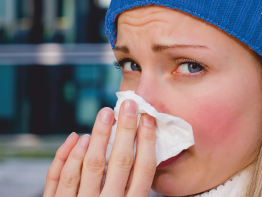15.01.2018
The Relationship Between Dry Air and Viral Infections
When it comes to the ages-old debate of dry air vs. humid air, striking a balance between these two extremes is crucial.
Viral infections such as influenza are directly influenced by the quality of an environment’s air, which includes relative humidity levels and temperatures. Therefore, do ciruses spread in dry air? Absolutely - and more readily. If relative humidity levels are low – less than 40% RH – the space will effectively become a breeding ground for bacteria and viral infection potentialities. In this blog entry, we’ll explore the relationship between low-humidity conditions, the drier environments they create, and the viral infections they directly encourage.Aerosols and Moisture Content
Every human being coughs, sneezes, breathes, and talks, true, but most of the time we don’t realize the impact our own bodies have on an environment with low relative humidity. We produce and release microscopic water droplets, which are known as aerosols. They typically consist of 97% water and 3% solutes (such as salts, proteins, and similar substances). In properly humidified conditions with 40% to 60% RH, the aerosols we produce have no negative impact on us or our environment, as this moisture content acts as a defensive barrier.
Drier Conditions Enable Transmission of Airborne Viruses
When someone is ill with a respiratory or viral infection, the aerosols they produce contain harmful and highly infectious microbes. In poorly humidified conditions with low relative humidity (below 40% RH), an aerosol virus in more easily dispersed throughout the air of an environment. This is due to the fact that in dry atmospheres, aerosols rapidly lose their moisture content due to the evaporation process. These droplets therefore reduce in size and are capable of remaining airborne for far longer. Therefore, more droplets remain airborne and can effectively float freely with minimal gravitational pull. As a direct result of such circumstances, the potential for the transmission of aerosol viruses increases exponentially, putting occupants at a far greater risk of becoming infected and developing health issues. In addition, drier conditions enable for allergic and asthmatic triggers such as mold, mites, mildew, heavier air, and allergens to fester. This is largely due to the fact that nasal passages don’t retain sufficient moisture in low-humidity environments, which otherwise acts as a form of defense against asthmatic attacks and allergic reactions.
Droplet Crystallization
When aerosol droplets interact with conditions containing low relative humidity (RH) levels, it can cause their very structure to change, becoming more potentially harmful. Infectious microbes such as viruses and bacteria are preserved in this state, which is the result of losing moisture content due to the evaporation process. They then remain infectious for longer and can inherently infect other humans far more easily.
The Importance of Balanced Relative Humidity (RH) Control
When factoring in the relationship between low-humidity conditions and viral infection potentialities, it becomes clear that maintaining consistently balanced relative humidity (RH) levels in any environment is essential. Once 40% to 60% RH is reached and maintained, the quantity of microbes in the air is drastically reduced as they are made heavier with greater moisture retention in their host aerosol droplets. This effectively inhibits their infectious capabilities and transmission potentialities by forcing them to fall and settle more quickly due to being heavier. Additionally, the dissolved salts inside remaining droplets can help to eliminate remaining microbes, exponentially decreasing their infectious nature and any subsequent health risks. This helps to keep environments safer, healthier, and more productive by reducing absenteeism, the potential for transmission of airborne viruses, and impacts on workplace efficiency and/or productivity. For example, a classroom of students will benefit from better infection control in the event of an outbreak of influenza, which would otherwise spread rampantly from person to person in low-humidity conditions.
The humidity of air in an environment heavily influences the potential for viral infections. Dry air viruses can lead to serious health and wellness complications, usually stemming from a wide array of issues for occupants of an environment including dry skin, irritation, discomfort, dry eyes, and breathing issues. In addition, however, it serves as an opportunity for harmful aerosol-based microbes and bacteria to transmit through the air from person to person. By introducing proper relative humidity control to your space, such as with one of Condair’s energy efficient and incredibly clean humidifiers, air moisture content levels can be efficiently managed and maintained, and balanced relative humidity can be regulated. Those with proper humidification will notice greater productivity, efficiency, and higher quality air that is breathable and clear of unwanted elements such as chemicals and harmful bacteria. As well as instances of transmission of airborne viruses being prevented, most triggers of discomfort, various infections and respiratory issues are reduced, making environments safer and more comfortable for occupants.
For more information on how to improve your environmental conditions through optimal relative humidity control, discover Condair’s line of humidification systems in our Best Humidifier Guide.
Similar Links:
http://jvi.asm.org/content/88/14/7692.full
https://www.condair.com/humidity-health-wellbeing/dry-air-and-airborne-infection
https://www.condair.com/humidifiernews/blog-overview/can-better-air-hydration-combat-mrsa-infections


